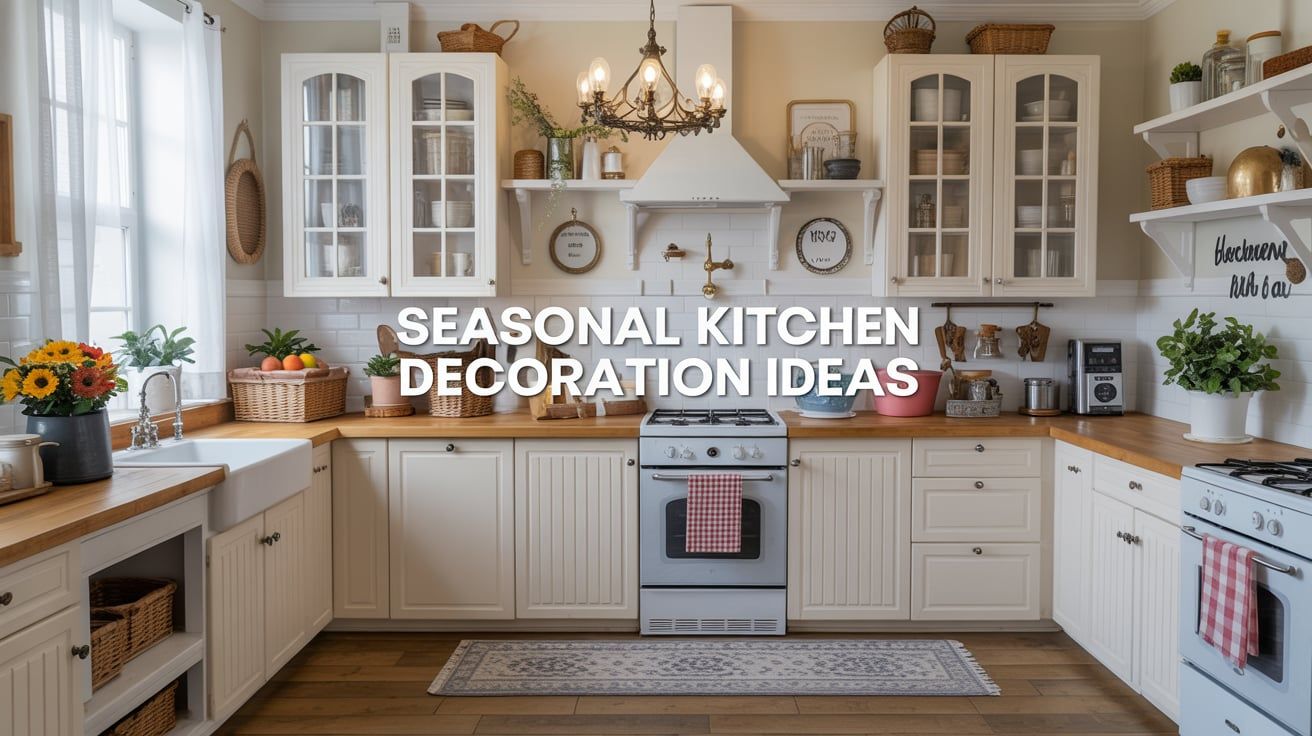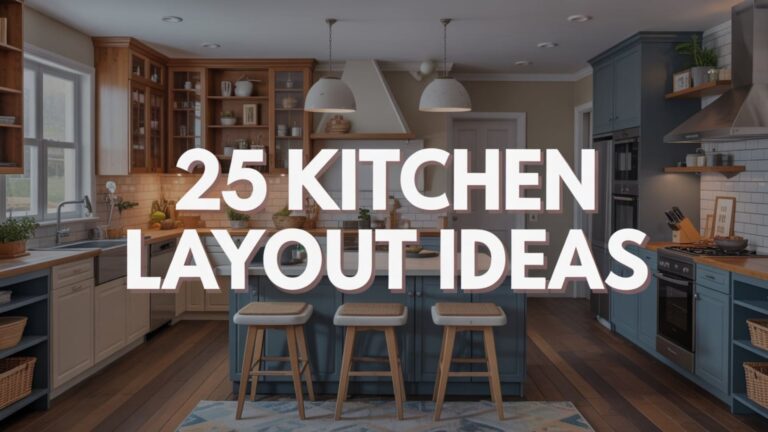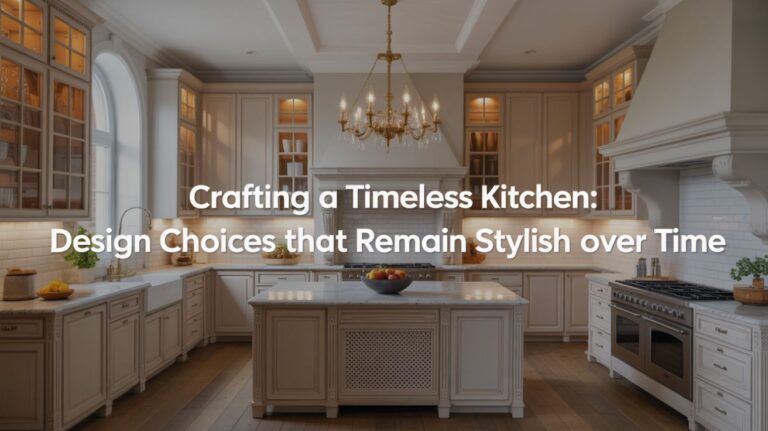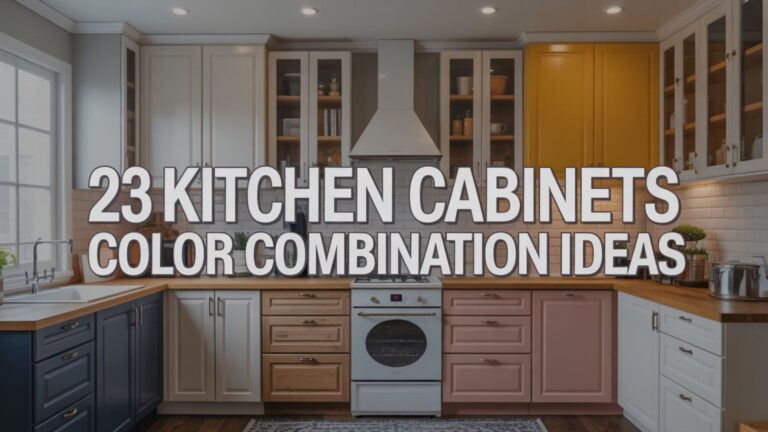Planning for Seasonal Kitchen Decoration: Keeping Your Space Fresh Year-Round
I have been, or can be if you click on a link and make a purchase, compensated via a cash payment, gift, or something else of value for writing this post. As an Amazon Associate, I earn from qualifying purchases. Please read my full Affiliate Disclosure for more information.
To plan seasonal kitchen decor that stays fresh year-round, start with a practical rhythm: baseline displays, a focal centerpiece, and minimal clutter. Rotate accents by swapping textiles, jars, and small details each season, keeping neutral walls and cohesive textures. Use cohesive palettes that mix warm and cool tones, and layer surfaces with varied textures—wood, ceramics, fabrics—while controlling lighting to highlight accents. Create organized zones, label storage, and a simple calendar to stay proactive. Curious how to expand this approach? Keep exploring.
Key Takeaways
- Establish a repeatable seasonal rhythm: rotate colors, textures, and accents while keeping a calm focal centerpiece.
- Swap textiles and jars seasonally: update linens, towels, placemats, and jar labels for instant cohesion.
- Use cohesive, versatile palettes: mix warm and cool tones with varied textures and balanced lighting.
- Organize storage by use: label clear containers, create seasonal zones, and perform quick 30-second purges before storing.
- Build a seasonal decor calendar: plan quarterly goals, block prep time, and leave buffers for last-minute adjustments.
Seasonal Styling Rhythm: A Practical Approach for Your Kitchen

Seasonal styling isn’t about a full redo every few weeks; it’s about rhythm—a practical, repeatable sequence you can follow in your kitchen. You’ll plan a light, intentional calendar that respects seasonal lighting and culinary traditions, guiding what to adjust and what to keep. Begin with a baseline display: a focal centerpiece, minimal clutter, and predictable textures. Then rotate accents by season: colors, materials, and optional accessories. Schedule quick checks for balance, then document simple cues to trigger changes. The result is cohesive mood, enhanced function, and a space that feels refreshed without waste. Your kitchen becomes both gallery and workspace, gracefully evolving.
Quick Swaps to Refresh: Textiles, Jars, and Small Details
Quick swaps are your fastest way to refresh without a full overhaul: textiles, jars, and small details can shift the vibe in minutes. You’ll start with textile swaps—swap in seasonal linens, towels, and placemats that echo the mood you want, without overhauling furniture. Then consider jar updates: switch labels, lids, or glass shapes to reveal new contents or simply feel lighter. Add a small detail, like a decorative tray or a single centerpiece accent, to unify the look. These easy changes require little investment and offer instant cohesion. textile swaps, jar updates empower quick, intentional refreshes.
Color Magic: Crafting Seasonal Palettes That Work Year-Round
You’ll start by choosing Seasonal Hues that feel cohesive across textures and lighting, so your kitchen reads unified year-round. Consider Palette Versatility Tips to mix warm and cool tones and keep decor flexible for any season, from spices to blooms. Tweak Accent Color Psychology to pick pops that energize cooking areas without shouting, guiding the eye to key tasks.
Seasonal Hues Harmony
How can a kitchen glow with color without shouting different seasons at once? You craft Seasonal Hues Harmony by selecting cohesive palettes that breathe year-round. Begin with a base of neutral walls, then layer subtle accents that reflect evolving light—warmth in winter, brightness in spring, calm in autumn. Use color blocking to group items by temperature, not trend, so contrast stays intentional and calm. Integrate decorative trays to anchor scenes, rotating textiles and ceramics as mood shifts occur. Keep finishes matte or satin to prevent glare, allowing texture and hue to speak. Practical, aesthetic decisions ensure versatility without visual fatigue.
Palette Versatility Tips
Palette versatility starts with a reliable core: a neutral foundation you can layer seasonal accents onto without disrupting flow. You’ll keep spaces flexible by pairing colors in repeatable segments: use one dominant hue, a supporting tone, and an accent for contrast. Color pairing becomes your toolkit for shift, not upheaval. For year-round balance, choose textures and finishes that echo the core while allowing seasonal pops. This approach aids mood setting: softer palettes calm for winter, brighter combinations enliven spring, and deeper tones ground autumn. Maintain harmony with proportional tweaks, not full overhauls, so your kitchen remains fresh, cohesive, and purposeful.
Accent Color Psychology
Accent color isn’t just about looks; it’s a quick mood lever you can pull to shape the room’s feel without overhauling the whole kitchen. In this section, you’ll learn intentional pairing of color psychology with practical use. Choose one or two accent hues that support your seasonal goal—calm blues for winter coziness, sunny yellows for spring energy, earthy greens for autumn balance. Apply them to small surfaces: accessories, towels, or a focal wall. Balance brightness with neutrals to prevent overwhelm. Test contrasts under natural light, then adjust saturation. Clear palettes guide mood shifts without clutter.
Texture and Layering: Adding Depth Without Clutter
Layered textures add tactile interest without overcrowding your counter, using a mix of fabrics, wood grains, and ceramic glazes to create depth. Let light guide the arrangement—soft shadows, reflective surfaces, and subtle accents keep things bright and breathable. Start with clear surfaces, then layer one or two tactile elements to reveal texture while preserving calm, organized space.
Layered Textures, Light
Texture and layering work together to give your kitchen depth without clutter: you can mix materials like wood, metal, ceramic, and textiles in small, thoughtful doses, so each piece has a reason for being there. Layered textures create visual interest, while lighting effects sculpt shadows and highlight details.
- Incorporate varied textures in a controlled palette
- Use warm, ambient light to soften surfaces
- Pair smooth ceramics with matte woods
- Add a subtle metallic accent for contrast
- Balance textures with negative space to prevent overwhelm
Subtle Accents, Clear Surfaces
You’ve set the stage with varied textures, now aim for subtlery that lets surfaces stay clean and readable. Subtle accents support depth without crowding, so choose quiet contrasts: a matte tray, a glass bowl, a single ceramic piece. Prioritize minimalist clutter over ornament overflow; each item earns its place. Create balance with occasional vertical height and low profiles that don’t interrupt sightlines. Use decorative vignettes sparingly—one curated scene per counter keeps focus intact. Store seasonal tools and props out of sight when not in use, then reveal a calm surface that enhances cooking and conversation. Subtlety, order, flow.
Scent + Ambiance: Gentle Fragrances That Elevate the Space
Scent can set the mood of your kitchen before you even step in, and gentle fragrances make that mood inviting rather than overpowering. You’ll create a calm atmosphere with approachable options that respect space and routine. Use soft, natural scents to reinforce seasonal mood without clashing with cooking aromas. Balance intensity by layering subtle notes and occasionally revitalizing them.
- Herbal infusions for a gentle, living smell
- Aromatherapy diffusers on low settings
- Fresh citrus peels in a shallow dish
- Light herbs tucked in a small sachet
- Unscented, breathable textiles nearby
Functional Decor: Balancing Beauty With Everyday Use
In a busy kitchen, beauty should enhance function, not compete with it; thoughtful pieces merge style with practicality, so you genuinely use them. Functional decor respects daily rhythms, helping you locate items fast and clean with ease. Choose decorative storage that hides clutter while keeping essentials accessible, like labeled jars or a compact canister set. Opt for artful displays that double as organizers—recipes on a magnet board, bowls as risers, a stylish utensil holder. This balance preserves a calm, inspired space, inviting you to cook more mindfully. Practical elegance ensures seasonal flair without sacrificing usability or efficiency.
Sustainable Choices: Eco-Friendly Decor on a Budget
Sustainable choices in budget decor prove you don’t have to overspend to feel virtuous about your kitchen. You’ll lean toward practicality with a mindful, minimalist approach, choosing pieces that last and inspire. Seek items made from recycled materials, or upcycle what you already own for fresh impact. Prioritize neutral palettes, simple lines, and versatile textures. Focus on function-first accents that enhance cooking flow and cleaning ease. The goal is restraint, not deprivation.
- Recycled materials as core elements
- Upcycled containers repurposed for storage
- Neutral hues and simple shapes
- Multiuse, space-saving designs
- Honest, sturdy construction over trendiness
Storage Shortcuts: Decluttering Your Seasonal Switch
Seasonal switches don’t have to mean chaos; with a few simple storage shortcuts, you can declutter as you rotate. You’ll start by grouping items by use, then label bins for quick access. Use clear, stackable containers to see contents at a glance, and dedicate a single tote for out-of-season pieces. Create zones: everyday, occasional, and seasonal, so rotation is predictable rather than disruptive. Practice creative storage—fold, stack, and compress where possible. Apply decluttering techniques like a 30-second purge before storing. Regular audits prevent buildup and keep your kitchen serene, functional, and ready for fresh seasonal touches.
A Flexible Calendar: Planning for Holidays and Seasonal Milestones
With a clear, adaptable calendar, you can map out key dates without feeling overwhelmed, weaving in holiday rituals and seasonal milestones as they arise.
- Build a master sheet with quarterly goals and note dates for holiday traditions and seasonal lighting ideas
- Block prep time ahead of peak seasons to keep decor fresh without chaos
- Assign tasks to weeks, so shopping, measuring, and setup stay organized
- Leave flexible buffers for last‑minute celebrations or changed plans
- Review and adjust monthly, celebrating progress and updating rituals as needed
This approach stays practical, structured, and aesthetically calm.
Conclusion
You’ve got a simple, repeatable rhythm for a kitchen that stays fresh year-round. Start with quick swaps—textiles, jars, small accents—then layer color and texture without clutter. Let scent and lighting cue the mood, while keeping function front and center. Choose sustainable pieces and smart storage so seasonal decor feels effortless, not overwhelming. Map a flexible calendar for holidays, then refresh with intention, not waste. With a practical plan, your kitchen remains stylish, calm, and endlessly adaptable.






